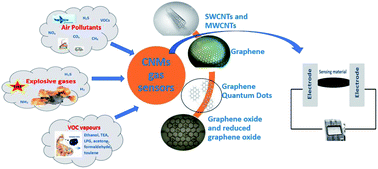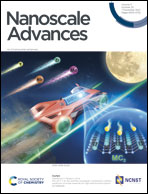Recent trends in gas sensing via carbon nanomaterials: outlook and challenges
Abstract
The presence of harmful and poisonous gases in the environment can have dangerous effects on human health, and therefore portable, flexible, and highly sensitive gas sensors are in high demand for environmental monitoring, pollution control, and medical diagnosis. Currently, the commercialized sensors are based on metal oxides, which generally operate at high temperatures. Additionally, the desorption of chemisorbed gas molecules is also challenging. Hence, due to the large surface area, high flexibility, and good electrical properties of carbon nanomaterials (CNMs) such as carbon nanotubes, graphene and their derivatives (graphene oxide, reduced graphene oxide, and graphene quantum dots), they are considered to be the most promising chemiresistive sensing materials, where their electrical resistance is affected by their interaction with the analyte. Further, to increase their selectivity, nanocomposites of CNMs with metal oxides, metallic nanoparticles, chalcogenides, and polymers have been studied, which exhibit better sensing capabilities even at room temperature. This review summarizes the state-of-the-art progress in research related to CNMs-based sensors. Moreover, to better understand the analyte adsorption on the surface of CNMs, various sensing mechanisms and dependent sensing parameters are discussed. Further, several existing challenges related to CNMs-based gas sensors are elucidated herein, which can pave the way for future research in this area.

- This article is part of the themed collections: Popular Advances and Recent Review Articles


 Please wait while we load your content...
Please wait while we load your content...